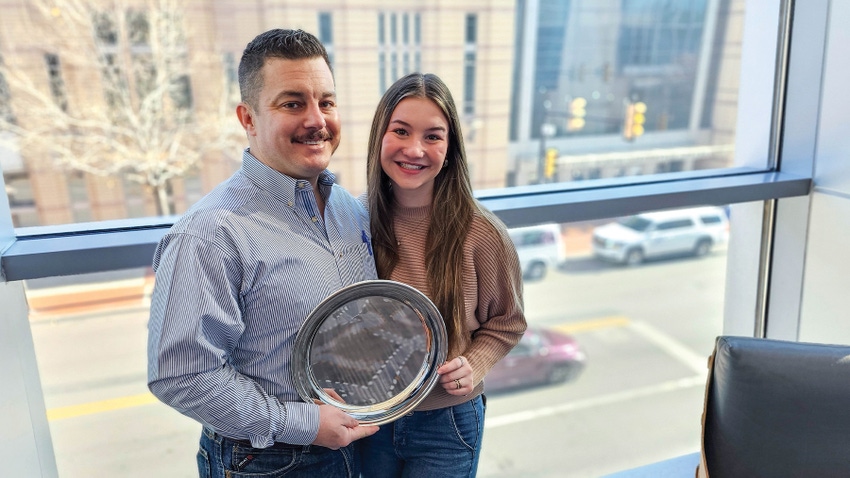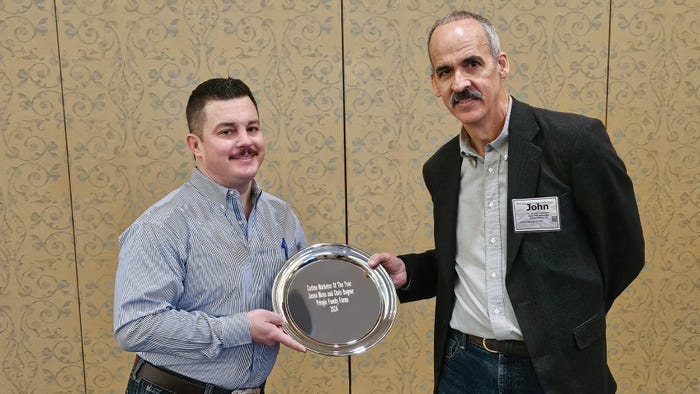
“Marketing is one of those parts of farming that’s humbling,” said Jason Moss as he received the Joe O’Neill Cotton Marketer of the Year award at the recent Beltwide Cotton Conferences, Fort Worth, Texas.
Moss, accompanied by his daughter Madeleine, accepted the award on behalf of Pringle Family Farms, a farming partnership he shares with Chris Bogner near Pringle, Texas. Together they operate 8,000 acres of corn, sorghum, cotton, wheat and cattle, of which cotton encompasses 2,500 acres. In addition to farming, Moss is also a senior marketing consultant for Brock Associates.
Following the presentation, Moss cited as his keys to his success a diverse set of marketing tools and a focus on the decision-making process. “As farmers, it’s easy for us to think that what we need is the best price forecast or the best weather forecast or the best information,” he told Farm Press. “But what we really need is to focus on how we turn information into decisions.”

Right, Texas A&M Extension Cotton Economist and Farm Press columnist, John Robinson, presents Jason Moss, Pringle Family Farms, with the Cotton Marketer of the Year award.(Photo by Shelley E. Huguley)
Diversification is beneficial as well. “I like to put a fifth to a third of the crop into various pools and then on the rest, because in Texas, we use acre contracts instead of bale contracts, I call the price on the futures on those.”
From Illinois to Texas
While Bogner grew up in Colorado, Moss’s agricultural roots originated on his family’s West Central Illinois farm. “I’m a corn, soybean, and hog farmer from the Midwest,” he said. In 2006, as he began consulting with producers at Brock Associates, Moss’s clientele expanded to include Texas Panhandle producers.
In 2014, a farm in the Stinnett, Texas, area came up for sale. “I pushed the numbers on it and then ended up branching out. I bought a farm and a couple more the next couple of years, and then began farming with my current partner and it grew from there.”
It wasn’t until 2019, that he talked his wife Megan into moving the family to Texas. “It was right in the middle of COVID,” he said. Plans were to move during the summer of 2020, but with Illinois schools closed, they relocated in April instead.
“Everything in Texas was shut down at that time,” Moss recalled. “I thought my family wanted to kill me. ‘Here, you move us to this middle of nowhere. We can't go anywhere. We don't know anybody.’
“It was rough,” he admitted, but it didn’t take long for them to call the Lone Star State home.
Moss and Bogner grow primarily irrigated cotton and corn. “It’s irrigation country. Our odds of making a dryland crop are a one-in-three type of odds, so dryland farming is really an insurance game,” he said. “We do grow a fair amount of dryland milo, wheat and sometimes cotton.”
They also have a seedstock Angus operation with about 1,000 cow/calf.
Marketing is not static
Based on his career as a consultant and as a producer, Moss shared some observations and considerations when it comes to marketing crops.
Market plan development and knowing production costs should not be a one-time decision. “Sometimes we treat marketing like a static document or thought that we prepare once a year but never keep coming back to it regularly and addressing it.
“What I always say is look at your sales history. It’ll surface your biases or if you have certain beliefs. If you market your crop in 10 or less total transactions a year, you could stand to diversify and make more decisions.”
Embedded biases can be things like, “You have to market ahead,” or “I can’t deliver to ‘that’ elevator,” or “You have to use crop insurance when you market,” Moss said. If biases are unrecognizable, Moss encouraged having someone like a spouse, review your sales history. “It’ll be obvious.”
Next, set parameters that will help steer marketing decisions. “Set some parameters, like a minimum sold at planting or a minimum sold before harvest, or the minimum amount you might diversify into the elevator programs or a maximum amount unsold in on-farm storage January 1, at the turn of the year.”
The biggest marketing regret he sees is quantity-related, not price. “We sell too much or too little or all of it or none of it. It’s never that this price is bad.
“My hallmark belief is always know where you want to sell your next bushel [or cotton bale]. If you don’t want to sell cotton today, that’s fine. But today, be able to say at what price you do want to sell the next bale of cotton.”
Marketing misconceptions
Avoid assuming all cotton contracts are made alike. “Our gin, Moore County Gin, north of Dumas, does a good job putting in front of growers the current contracts available from each of the cotton merchants. If you dig into them, there’s quite a few differences.”
Don’t assume there’s only a few ways to market a crop. “There’s actually several different types of contracts from several different companies,” Moss said.
Marketing 101
A basic marketing approach should encompass time, price and quantity. “For example, if I had unsold cotton right now, and I think that the March cotton could range from 77 to 85 cents, and I have 30% of my crop left to market, I might stick 5% to 10% orders between 82 and 84.
“Taking an expected price range over an estimated timeframe to break quantities.”
If a client says, “’I have an amount that’s unsold, should I sell it?’ What they’re really asking is is the price going to go up or down? What I need to know is what’s your drop-dead date, where you’re going to sell it anyway, regardless of what I tell you or what the market does. And then we back into it.
“If I have between now and Feb. 15th to sell this much production, here’s what we think the price could do over that timeframe. Let’s put some orders here and if we’re wrong, and it goes the other way, and you still have to sell, have a capitulation price point at which you admit you’re wrong and sell it anyway.”
2024 outlook
As producers begin 2024, Moss said to watch how prices react to USDA’s March acreage report. “It seems like every year, cotton acreage, in competition with grains, comes down to the last minute. What prices do between now and planting, or between now and the acreage report, how prices react after that, that takes grain acres up and down.”
He expects planted cotton acres in the Panhandle to be higher this year, “because a lot of acres that were intended to be planted last year, didn’t get in the ground because of the record-wet May and June we had. So, for some rotation, there’s going to be a lot of cotton intended to go back in the ground. We’ve had some moisture over the winter, so there will probably be a lot of dryland acres that’ll get seeded to cotton.”
The Joe O’Neill Cotton Marketer of the Year award is named after Joseph J. O’Neill, a former CEO of the New York Cotton Exchange, and sponsored by BASF and ICE Futures, formerly known as the New York Stock Exchange.
Are you curious who attended Beltwide? Take a look!
About the Author(s)
You May Also Like






